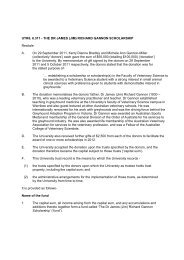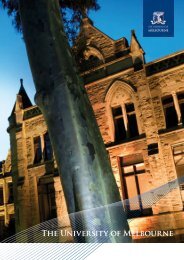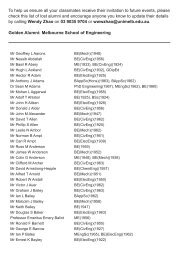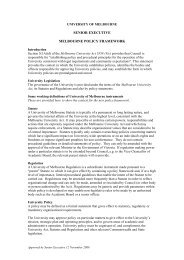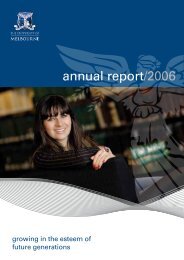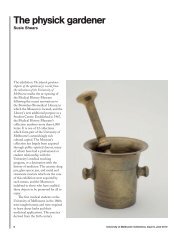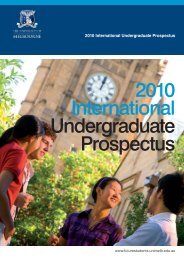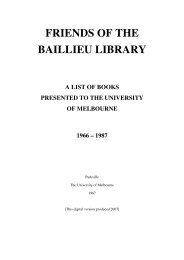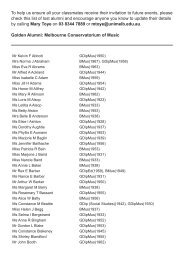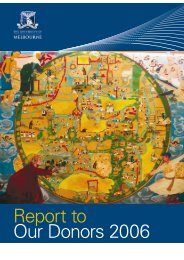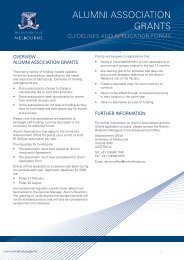Review of Australian Higher Education The Bradley Review
Review of Australian Higher Education The Bradley Review
Review of Australian Higher Education The Bradley Review
You also want an ePaper? Increase the reach of your titles
YUMPU automatically turns print PDFs into web optimized ePapers that Google loves.
Overview<br />
<strong>The</strong> new Commonwealth Government came to<br />
<strong>of</strong>fice promising an ‘education revolution’, and<br />
the <strong>Bradley</strong> <strong>Review</strong> <strong>of</strong> higher education policy is<br />
intended to give it advice on how to implement<br />
that revolution. This submission details the many<br />
problems in or flowing from higher education—<br />
from the crisis in the medical workforce to student<br />
poverty to lost research opportunities—that justify<br />
significant change. In response, this submission<br />
proposes radical structural changes in how<br />
university places are distributed and paid for, and<br />
major improvements to student income support<br />
and to research funding policy.<br />
<strong>The</strong> largest suggested change is to how student<br />
places are distributed between higher education<br />
institutions. Currently, the Commonwealth<br />
allocates these places. This system has shown<br />
itself to be inflexible in the face <strong>of</strong> both student<br />
and labour market demand. <strong>The</strong> health workforce<br />
has been desperate for extra staff while<br />
applicants for health courses are turned away in<br />
their thousands. <strong>The</strong> system needs automatic<br />
adjustment mechanisms, and this submission<br />
shows how letting universities respond to student<br />
demand would have avoided or alleviated current<br />
labour market shortages.<br />
Just as the distribution <strong>of</strong> student places has<br />
stayed the same while circumstances change,<br />
funding per student place has drifted, mostly<br />
down, as costs have risen. In some fields <strong>of</strong><br />
study this is mainly the upward pressure <strong>of</strong><br />
salary costs, as universities compete to retain<br />
highly-skilled academic and pr<strong>of</strong>essional staff. In<br />
other cases, technological change has rendered<br />
cost assumptions <strong>of</strong> the past irrelevant. <strong>The</strong><br />
funding system needs to be responsive, and<br />
this submission proposes that base funding be<br />
reassessed, with universities able to charge<br />
additional amounts on top <strong>of</strong> that figure.<br />
<strong>Higher</strong> education needs to avoid the risks to<br />
educational quality and diversity <strong>of</strong> government<br />
budget constraint.<br />
<strong>The</strong> social inclusion goals <strong>of</strong> the past need to be<br />
kept, but the methods rethought. As a percentage<br />
<strong>of</strong> the university population, enrolments <strong>of</strong><br />
students from low socioeconomic backgrounds<br />
have remained unchanged over many years.<br />
While the fundamental causes are educational<br />
aspirations and school results, there is more that<br />
can be done in post-secondary school policy.<br />
<strong>The</strong> submission’s proposal to drop limits on the<br />
number <strong>of</strong> Commonwealth-supported places will<br />
provide immediate additional opportunities. It also<br />
calls for greater integration <strong>of</strong> the vocational and<br />
higher education sectors, to smooth pathways<br />
between the two.<br />
Redesign <strong>of</strong> the student income support system<br />
will support social inclusion goals. Three different<br />
income support programs target overlapping<br />
groups, making the system very complex. Some<br />
students receive nothing or benefits with earning<br />
limits that cut in before the poverty line, while<br />
others can live at home in relative affluence. <strong>The</strong>se<br />
anomalies need attention.<br />
Though research is not a formal part <strong>of</strong> this<br />
review’s terms <strong>of</strong> reference, it is so integral to<br />
what universities do that it cannot be omitted from<br />
consideration. Problems with research funding, for<br />
example, undermine the career prospects <strong>of</strong> staff<br />
who are also needed for teaching. Universities<br />
face a serious problem with replacing their<br />
workforce over the long term.<br />
So the <strong>Bradley</strong> <strong>Review</strong> is an important one.<br />
<strong>Higher</strong> education in Australia does have huge<br />
potential. With the right regulatory framework for<br />
international students, universities helped create<br />
Australia’s third largest export industry in just<br />
20 years. But realising that potential does indeed<br />
require an ‘education revolution’.<br />
University <strong>of</strong> Melbourne <strong>Bradley</strong> <strong>Review</strong> Submission






